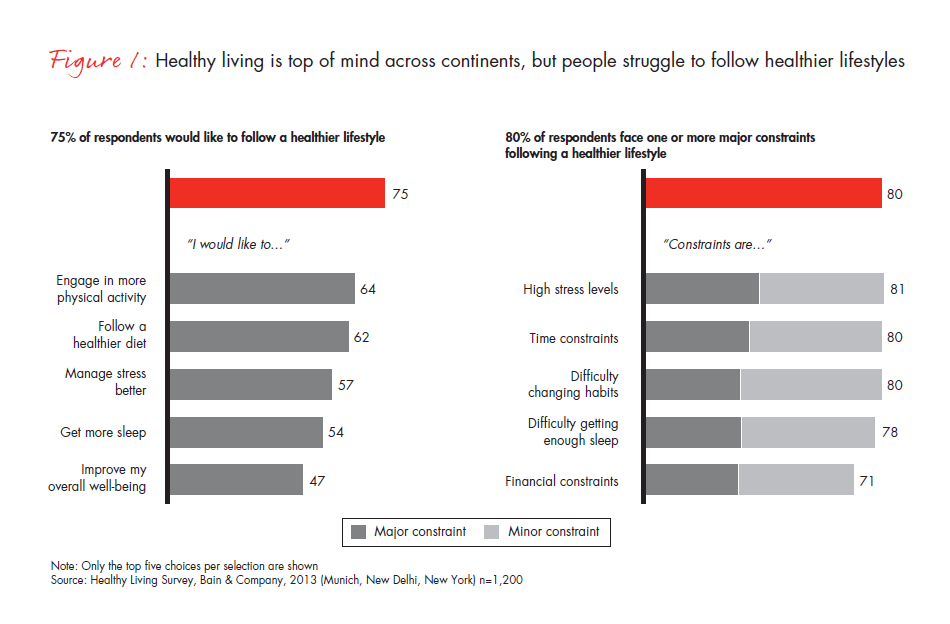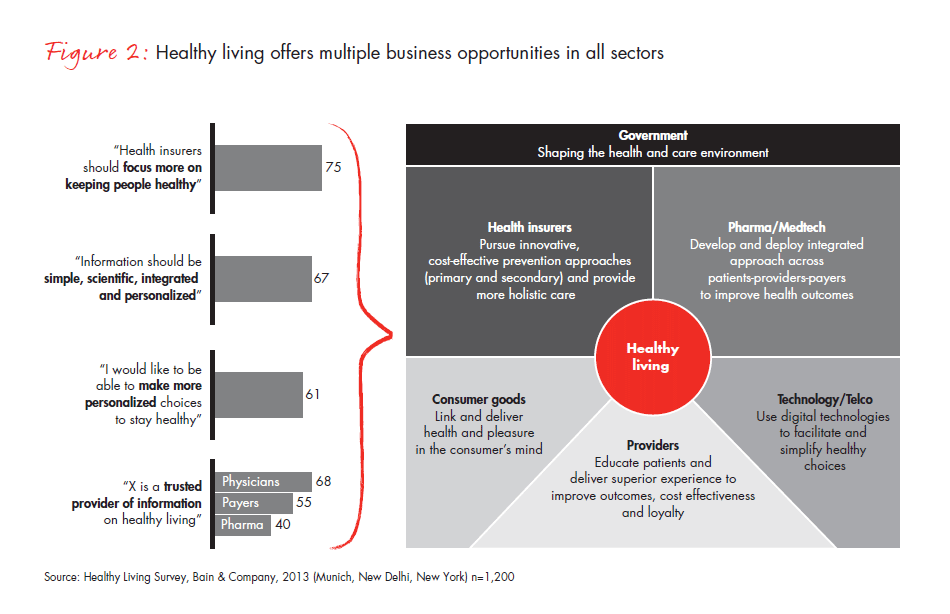Etude
Healthy living is now a mainstream topic. It is no longer just a story in the Style section or something only fitness fanatics value. A recent Bain & Company online survey of 1,200 adults in New York City, Munich and New Delhi reveals surprisingly few cultural or demographic differences in the significant value people put on living healthier lifestyles or the challenges they face in making that happen.1
What do consumers say about healthy living? What do they see as the major barriers to doing what they know they should do? And what are the business opportunities for companies as they create new markets for their products and services to respond to consumer demand?
Consumers around the world are looking for innovations that can help them lead healthier lives, creating significant opportunities for businesses. To take advantage of these opportunities, major stakeholders will need to partner with consumers and each other in new ways, says Norbert Hueltenschmidt, a partner in Bain's Healthcare practice.
We surveyed people across three continents and found a broad consensus about the value of healthy living. After decades of emphasis on curing disease, consumers increasingly realize that staying healthy requires a real behavioral commitment, as well as new and more productive relationships with health and care stakeholders. When asked to choose between easy, affordable access to world-class medical care vs. easy, affordable access to healthy living options, more than half of those in all three cities surveyed chose healthy living, even though those cities offer high-quality medical care. In New York City more than half of the respondents chose healthy living, while in Munich and New Delhi, the percentages were 69% and 76%, respectively. Media attention on obesity and preventable disease may have resonated with these respondents, as they realize there are actions they can take to stay healthy and avoid using medical care.
Respondents said they understand what healthy living means, and they have good intentions to do something about it (see Figure 1). More than 80% believe they have a good understanding of what it takes to maintain a healthy lifestyle. Nearly two-thirds of New Delhi respondents said they read articles about healthy living at least once a week, and 29% in Munich and 42% in New York agreed. And 75% of respondents indicated that they would like to follow a healthier lifestyle. These are good sentiments, but how do respondents intend to apply what they know? No matter which city they live in, more than half of respondents have similar priorities of engaging in more physical activity, following a healthier diet, getting more sleep and managing stress better.

About 80% of respondents indicated they face at least one major constraint to living healthier lifestyles. While about half of respondents readily admitted they don’t meet the World Health Organization’s recommended minimum physical activity level for their age group, the reasons they gave reinforce the constraints of a busy workforce—stress, lack of time and the vexing difficulty of changing old habits. Financial constraints are a factor as well. Younger respondents in Munich and New York cited high stress levels and time constraints two or three times as often as the 60- to 65-year-old respondents did. Lack of knowledge about what to do and lack of support from family or employers were less frequently cited.
Most respondents claim they would be willing to spend more on a variety of products and services that support healthy living, but there is a gap between desire and action. While we can’t predict how much money consumers would actually put on the table, “likeliness to spend” responses in the survey suggest an opportunity for companies in many sectors to test out this hypothesis as they develop new products and services.
What can businesses do to promote healthier living? Who do consumers trust to inform them about their options?
Consumers are looking for innovative, personalized solutions to help them change their habits (see Figure 2). There is no doubt that government can play a role by setting the framework for prevention and community empowerment through policy and regulation. But government cannot do it alone. Private-sector opportunities to promote healthy living are evolving at a rapid pace, demanding a complete break from old roles and a new “cross-sector” language of integration that can capture the imagination of consumers. Insurers of the future will not look or act like they do today; technology companies will catalyze change by using Big Data to help consumers and patients create faster and easier ways to pursue health. Pharmaceutical and medtech companies will show that their products can prevent as well as treat disease, and consumer goods companies will engage consumers more powerfully at the point of purchase.

Insurers should focus on keeping people healthy
More than 70% of all respondents agreed that “health insurers should focus more on keeping people healthy instead of just reimbursing medical expenses to treat disease.” Despite practical barriers to providing preventive services, such as member turnover and the lack of evidence of the effectiveness of many services, some insurance companies are forging ahead. Discovery, an insurer in South Africa, has successfully introduced a consumer-focused health insurance product called Vitality. Vitality includes a broad incentive-based pro-gram that offers rewards such as discounts on vacations, flights and consumer products to members for practicing healthy behaviors. Measurable outcomes include reduced hospital admissions, member satisfaction and profitable growth.
The insurer of the future will also need to find new ways to engage primary care physicians. This type of partnership will be critical to attracting and retaining satisfied members. Blue Cross Blue Shield of Massachusetts, the largest health plan in the state, has initiated a new way to collaborate with physicians via an “alternative quality contract,” which pays primary care physicians for value, not volume, and holds them accountable for patients’ health in addition to their healthcare. Physicians are paid a flat amount per member per month and are eligible for significant bonuses, so they are rewarded financially for outcomes that demonstrate better quality and higher patient satisfaction.
Insurers also have the opportunity to educate patients more effectively and provide a more holistic and integrated approach to care that is not segmented by disease or condition.
Technology and telecom companies can provide digital technologies to facilitate and simplify healthy choices
With time constraints cited by respondents as a major barrier to healthy living, consumers will welcome solutions that make the pursuit of health quicker and easier. The younger cohort of respondents in New Delhi appear to be the most open to technological solutions, which suggests attractive opportunities for piloting innovative approaches in developing markets.
Although there are many technology solutions that lend themselves to healthy living in general, in the field of diabetes prevention and treatment, there are hundreds of companies making smartphone applications that help patients monitor their health. One such company is Omada Health, a start-up that has launched a product called Prevent, which offers evidence-based digital tracking tools and an online program for people at risk for diabetes. Other digital tools include apps that keep track of miles walked or run and heart monitoring tools such as AliveCor, which sends ECGs taken at home to physicians via smartphones. The market is flooded with opportunity, but the innovative company will link players together and focus on what respondents in this survey have identified as their preference—evidence-based, personalized and time-saving tools.
Pharma and medtech can integrate feedback and messaging across patients, payers and providers to improve health outcomes
Pharma and medtech companies have unique access to hospitals and physicians through their extensive marketing networks and strong professional relationships. This access allows them to partner more effectively with physicians, whom 68% of survey respondents have identified as among the most trusted providers of information. Bain has found that physicians with high Net Promoter Scores (NPS®), who are “promoters” of a medication, prescribe products two to three times more than “detractors.” As pharma and medtech companies become more customer-centric, they will be able to extend their customer feed-back and loyalty systems to include physicians, payers and patients in a more integrated manner. This will produce a powerful way to market their products more profitably.
Pharma and medtech companies can also seize the opportunity to partner with patients directly, moving beyond just promoting a pill or device and investing in more innovative approaches to keeping patients healthy. Secondary and tertiary prevention—keeping a disease from progressing—helps patients maintain control of a chronic disease while potentially improving reimbursement for the supplier of the medication or device.
Other opportunities include partnerships with technology companies to monitor and change patients’ behaviors, developing new products in the zone between food and pharma, as well as encouraging voluntary medical checkups that can provide earlier prescription of life-extending and life-enhancing drugs.
Consumer goods companies need to link and deliver health along with pleasure in the mind of the consumer
Consumer goods companies have a more straightforward challenge, because there is already growing demand for healthier food and new kinds of exercise equipment and programs. The challenge will be to personalize these products and services and price them affordably for consumers looking for quick and easy ways to stay healthy.
One company has already taken advantage of the demand for better tasting frozen food. Luvo (formerly Lyfe Kitchen) recognized that typical frozen dinners in supermarkets were neither healthy nor tasty. Based on the premise that you should love what you eat and what you eat should be nutritious and delicious, Luvo has developed a line of reasonably affordable frozen breakfasts and dinners, which are now available online and in retail markets as diverse as Target and Whole Foods all over the US.
Other companies are developing innovative health and well-being services or exercise equipment that makes it easier to work out at home. Whatever the product or service, the business opportunity lies in engaging consumers and strengthening the feedback loop between short-term pleasure and long-term health at the point of purchase.
Now more than ever, we need industries that support and enhance health in an innovative way. As much as we know about behavior change, it remains difficult for individuals to apply that knowledge to promote their own health or maintain their commitment to these activities. Results from the survey show that consumers understand what they need to do, but they want a lot more help doing it. Companies that can work across sectors, personalize their products creatively or develop a sustainable market for a product yet to be invented will create enormous value—for their shareholders and for the world.
Norbert Hueltenschmidt is the head of Bain & Company’s Healthcare practice in Europe, the Middle East and Africa, and is a partner based in Zurich. Tamara Olsen is a Bain partner based in Boston and a member of the firm’s Healthcare practice.
1 Bain & Company conducted the online survey in November 2013, with 1,200 respondents from Munich, New York City and New Delhi. There were 400 respondents in each city, with ages ranging from 21 to 65. Participants were selected through online research vendors, and represent a balanced demographic mix for Munich and New York and the online population in New Delhi, which is mostly under the age of 40 and well educated. To assess their attitudes, behaviors and expectations regarding healthy living, Bain asked participants to answer 45 questions. Data was analyzed across the overall survey population as well as for different subgroups. Data on city and segment levels can be shared upon request.

